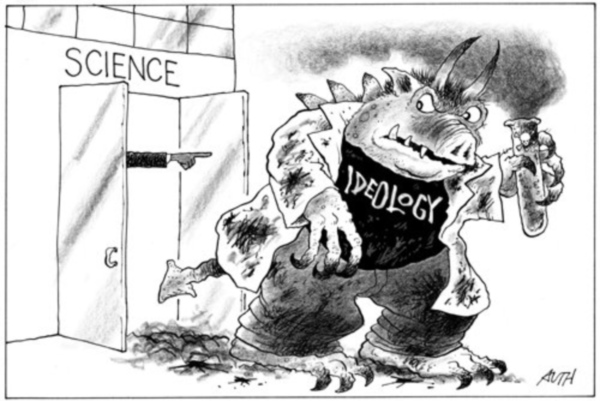
Groups like the American Lung Association – not to mention the vast majority of anti-vaping news coverage – would have you believe there is some huge dispute about the safety of electronic cigarettes.
Due to the recent emergence of the technology and the fact that most vapers are pretty young (so even if they were smoking definitively carcinogenic cigarettes, they wouldn’t get cancer for quite a while) there does need to be more research on e-cigarettes, but there is no serious dispute about their relative safety in comparison to cigarettes, and no reason to assume any risk to users or bystanders.
So why do we consistently see horrendously flawed pieces of research, vapid, unsupported statements about e-cigarettes and legislative actions taken to protect bystanders from a barrage of invented dangers? Because the anti-vaping movement, or more broadly the anti-smoking movement, is driven by ideology, and ideology is downright awful at science.
Summary
- Science is differentiated from pseudoscience by Karl Popper based on the notion that science makes testable and falsifiable predictions.
- Scientists driven by ideology – like Christian scientists – say stupid things like “the speed of light is decreasing” because they’re unable to admit that their ideological viewpoint has been clearly proven to be incorrect.
- This same issue – in a less obvious form – is widespread in tobacco and nicotine research, shown by false findings that continue unchecked for decades.
- Nicotine toxicity data is fundamentally flawed (with the lethal dose being between 10 and 20 times more than usually stated) and according to new research, second hand smoke exposure is not associated with lung cancer.
- These mistruths were believed for so long because anti-smoking ideology drives public and even scientific thinking about nicotine and tobacco.
- E-cigarettes are the latest chapter in this distortion of science by zealots, who conduct flawed research and even appear to specifically construct studies or misappropriate statistics to suit their pre-conceived ideas.
- Opposition to e-cigarettes is based on a core, un-falsifiable belief that there is some component (that studies just haven’t found yet) that makes e-cigarettes as dangerous as combusted tobacco or proves they’re a gateway to smoking, or anything that conforms their anti-nicotine ideology.
The Scientific Method and Falsification
Virtually everybody knows the scientific method, but it’s worth repeating here, because rigorous adherence to this method is how we gain new knowledge.
The five steps can be summarized as: 1) observe the real world, 2) come up with a hypothesis to explain an observed peculiarity, 3) make a falsifiable prediction based on that hypothesis, 4) test it, 5) and then see if others can reproduce the results of your test. If your hypothesis is shown to be wrong, then you have to come up with a new hypothesis or alter your old one and see if that works.
Karl Popper, a philosopher of science, was interested in how we can separate true sense from nonsense dressed up as science, otherwise known as pseudoscience.
The answer he came up with was that making falsifiable predictions is the hallmark of true science. A scientific prediction – the speed of light in a vacuum is always 299,792,458 meters per second, and that is the fastest anything can travel – could be proven to be wrong pretty simply (by finding something that travels faster), whereas an unscientific claim – an omniscient and omnipotent deity created the universe – is impossible to prove wrong.
If you don’t find God beyond the clouds, it’s because he lives beyond the stars, and so on until supporters are left to claim that God exists in a dimension we can never experience, outside our universe, or wherever we can’t see.
Ideology and Pseudoscience
The problem with mixing ideology and science is that to successfully appraise reality you need to be willing to throw away that hopeless hypothesis, hold your hands up and admit you’re wrong, and then change your mind. The issue ideological people come up against is that if you run around claiming something in the absence of empirical proof, people correctly assume that you’re either fundamentally deluded or are simply lying. To try to convert people to your beliefs – or prevent people from sensibly abandoning them – you need to pretend that you’re doing science.
This is why there are things like Christian “scientists”; which is an oxymoron with the emphasis on moron. They grapple with issues like: if the universe was only created about 6,000 years ago, why can we see stars where the light has taken 13 billion years to reach us? The obvious answer, that the universe is much older than that, can’t be accepted by these people, and so they come up with vaguely scientific-sounding but absurd theories about how the speed of light has been getting slower since the creation of the universe, with no supporting evidence whatsoever.
Of course, religions fundamentalists aren’t the only culprits, but they clearly show the issues with taking ideological beliefs into a scientific discussion, if you aren’t willing to abandon them if they’re shown to be wrong.
Ideology is characterized by being entrenched a given position, cherry-picking data to suit your ends and even fundamentally abusing the scientific method to produce tests that – on the face of things – appear to support your hypothesis.
The widespread use of these techniques by groups such as homeopaths has led the Rational Wiki to propose an alternative scientific method used by those who “cheat” at science:
- Pick a personal belief that you want to ‘prove' is true.
- Make new observations or experiments, and note the results.
- Think up some clever way by which to shoehorn your personal belief to said results.
- Falsely claim that your personal belief predicts the particular results, and that the observations/experiment confirmed your suspicions.
Sound familiar?
Meet the ANTZ…
 The anti-nicotine and tobacco zealots, or ANTZ, are a strange breed of ideological group. Perhaps their parents smoked heavily and died of cancer, or maybe their quitting smoking was contingent on the notion that tobacco or nicotine in any form is the epitome of evil, but there is no doubt that this ideology exists.
The anti-nicotine and tobacco zealots, or ANTZ, are a strange breed of ideological group. Perhaps their parents smoked heavily and died of cancer, or maybe their quitting smoking was contingent on the notion that tobacco or nicotine in any form is the epitome of evil, but there is no doubt that this ideology exists.
E-cigarettes are by far the best example of this mania from anti-smoking groups, since – despite significant and undeniable evidence to the contrary – they continue to deny the fact that e-cigarettes are safer than cigarettes.
E-cigarettes are a technology that’s on their side, offering people an alternative to smoking with the potential to save millions of lives around the world, but because they look like cigarettes, they can’t bring themselves to see the evidence for what it really is.
SEE ALSO: Top 10 Logical Fallacies of Anti-Vaping Zealots
No big deal, right? So what if some idiots hate everything that resembles smoking – doesn’t the evidence speak for itself? Well, not really.
Firstly, journalists are responsible for telling people about the evidence, and they are prone to parroting information from press releases, pursuing political goals and outright misunderstanding the studies they’re talking about.
Secondly, and more importantly, ideological attitudes are dressed up as science. The anti-smoking movement is an area rife with pseudoscience, where researchers appear to follow the alternative scientific method as opposed to the actual one. The ideologies spread like viruses, and infect both the public and scientific view of the issues.
Distorting the Evidence
The problem is very well illustrated by two particular stories relating to nicotine and smoking research. Second-hand smoke is a concern in the modern world, with smoke-free policies having become ubiquitous and the risks so routinely repeated that it’s impossible to avoid knowledge of them. Why then, has a recent, huge, study found no correlation between second-hand smoke exposure and lung cancer?
Apparently, the reason for this is that the evidence in favor of the harm associated with second-hand smoking was always incredibly weak. The studies that showed the strongest evidence of the association were performed using an extremely – and painfully obviously – flawed methodology. They were case-control studies, meaning that people who already had lung cancer but were non-smokers were specifically asked if they’d been exposed to second hand smoke, and then matched with people without lung cancer who served as the controls.
The problem is “recall bias,” in other words, if you have lung cancer but you don’t smoke, of course you’re going to remember that you were exposed to second-hand smoke. This is one reason they lie right towards the bottom of the hierarchy of evidence; the design just isn’t reliable enough.
The best forms of evidence are randomized controlled trials and systematic reviews of existing evidence, but it’s understandable that you can’t assign people at random to either be exposed to potentially carcinogenic second-hand smoke or breathe free. The next best thing is a cohort study, like the recent research on over 76,000 women finding no link between second hand smoke exposure and lung cancer. As Christopher Snowdon points out, similar evidence has been around for a long time, it just gets ignored because it threatens the overriding ideology. In fact, after the “dangers” of second-hand smoke were widely accepted by society, research pretty much stopped.
Even on the recent study, the authors pointed out “borderline” statistical significance for women living with a smoker for over 30 years, but Snowdon refutes this notion by pointing out that such a thing doesn’t exist. In this specific case, the imprecision in the figures and the fact the group’s incidence overlapped with the expected incidence of lung cancer in the “control” population means that it cannot be considered a significant result.
It’s undeniable that the reason it was given the imaginary quality of “borderline” significance by the researchers is because a completely null finding wholly contradicts the status quo. Like the Christian scientists claiming that light used to be faster than it is today to protect their young Earth conjecture, they feel like the conclusion they want to draw can be obtained if you squint enough while looking at contradictory facts. Forbes reports one of the researchers claiming that because only 4,000 participants hadn’t been exposed to second-hand smoke, it was hard to “tease out the difference.” If you’re trying to “tease out” a difference, it probably just doesn’t exist.
Another thing you often hear is how nicotine is the most toxic substance known to man. This is the sort of thing that anti-smoking zealots love, because they can say things like “nicotine is more poisonous than arsenic.”
Many sources of information still claim that 60 mg of nicotine is enough to kill an adult. These facts are accepted based on what toxicological sleuth Bernd Mayer refers to as “circular and often misleading references” which ultimately trace back to some dubious experiments from the 19th century. He cites evidence of people surviving after consuming considerably more than that, and points to reports of much higher blood nicotine levels measured in people who did die, ultimately suggesting that it would probably take more like 500 mg to 1000 mg to kill an adult.
The assumed toxic dose of nicotine has survived for over 100 years. Mayer’s article was published late last year, and although he cites other researchers questioning the figure in 1995 and 2005, it’s hard to think of such an extreme claim surviving in any other field of science for quite so long.
Again, it’s not an easy thing to test (you can’t risk poisoning somebody just to check a fact), but case studies throughout the 20th century should have led to widespread questioning of the accepted toxicity (particularly when based on such a weak source). But it seems like when smoking is concerned, the facts are just routinely hidden. People are just happy to repeat ultimately unsupported and fear-inducing statements without investigating any further, because it suits their ideology.
It’s hard to imagine a truly objective observer looking at the following toxicity doses for nicotine – dogs: 9.2 mg/kg, mice: 3.3 mg/kg, rats: 50 mg/kg, humans: 0.8 mg/kg – and not suspecting that something isn’t quite right. In fact, if you were a scientist in the field and were following the scientific method, you’d notice the peculiarity and investigate to see if there was a hypothesis which explained the discrepancy sufficiently well. When you found that there was none, you’d consider proposing one and testing it. You might investigate some dead ends, but you’d eventually stumble across the answer: the estimate is just wrong. This is how science is supposed to work; but something about nicotine and tobacco seems to slow progress somewhat, and that something is the over-riding anti-smoking ideology.
E-Cigarettes Are Just the Latest Chapter
 Regardless of this, the anti-smoking zealots have won. They’ve already got smoking banned from public places, and most people are still unaware that the nicotine toxicity data is wrong. E-cigarettes come onto the market – a technology invented specifically to help people enjoy nicotine without the associated risks and hopefully quit smoking altogether – and the ANTZs’ knee-jerk response is fear, hatred and unsupported lies.
Regardless of this, the anti-smoking zealots have won. They’ve already got smoking banned from public places, and most people are still unaware that the nicotine toxicity data is wrong. E-cigarettes come onto the market – a technology invented specifically to help people enjoy nicotine without the associated risks and hopefully quit smoking altogether – and the ANTZs’ knee-jerk response is fear, hatred and unsupported lies.
They’re fighting a hopeless battle because they’re literally incapable of distancing themselves from this ideological view and seeing the technology for what it really is.
The Rational Wiki quotes a particularly relevant line from Samuel Birley Rowbotham, referencing the famously deluded fictional “knight-errant” Don Quixote:
Quixotism is a folly when the energy which might have achieved conquests over misery and wrong, if rightly applied, is wasted in fighting windmills.
With smoking, the cases of rank distortion of evidence are few and far between, because smoking really is bad for you. With e-cigarettes and vaping, there are abundant examples of complete nonsense, in the form of stupid arguments, logical fallacies, and, worst of all, pieces of research which report unsupported conclusions or are arguably specifically designed to obtain them.
In short, e-cigarettes have divided the once unified anti-smoking researchers; some of them are smart enough to tell when something is on their side and the others aren’t.
 Dr. Stanton Glantz was a researcher on a cross-sectional study which looked at Korean adolescents, and although the study was merely a snapshot of tobacco use at one period of time (which means there is no hope of determining cause and effect from it), still claimed that it proved “e-cigarettes are a new route to smoking addiction for adolescents.” Dr. Michael Siegel was so aggravated by this misrepresentation of the findings that he asked why they even bother to do the studies, “If we are going to simply conclude what we want to conclude, regardless of the ability of the science to reach such a conclusion, then what's the point of doing the research in the first place?”
Dr. Stanton Glantz was a researcher on a cross-sectional study which looked at Korean adolescents, and although the study was merely a snapshot of tobacco use at one period of time (which means there is no hope of determining cause and effect from it), still claimed that it proved “e-cigarettes are a new route to smoking addiction for adolescents.” Dr. Michael Siegel was so aggravated by this misrepresentation of the findings that he asked why they even bother to do the studies, “If we are going to simply conclude what we want to conclude, regardless of the ability of the science to reach such a conclusion, then what's the point of doing the research in the first place?”
His satirical end-of-year post echoed this, and fits well with “the pseudoscientific method” from earlier, “The purpose of tobacco control research is to demonstrate preconceived conclusions. If the research does not support those conclusions, make up some excuse or draw those conclusions anyway.”
The core of the anti-vaping movement is based on one core premise which is impossible to falsify: “because they look similar to cigarettes, there is something, somewhere in e-cigarette vapor that is going to do serious harm to users, and we only don’t know what it is yet because they haven’t been researched enough.”
You might offer a systematic review of existing chemical studies, showing the contents of vapor as recorded by numerous objective assessments, or toxicological evidence of no harm to cells, but the response is the same, “they could still be dangerous because we still don’t know enough.” It seems scientifically-minded to say we need more evidence, but in fact, the only way you could possibly show this repetitive, God-is-somewhere-you-can’t-see style argument to be untrue is by thoroughly investigating every element of every possible way e-cigarette could cause harm. They have no evidence of harm in support of their view, just the irrefutable and therefore unscientific hypothesis that “there is a serious risk we’ve just not uncovered yet.”
Conclusion: Ideology Corrupts Science and Infects Public Thinking
Whether it leads anti-smoking groups to continually claim that there isn’t enough evidence of the relative safety of e-cigs with all the impotent determination of a climate change skeptic or drives respected researchers to just pretend that their data supports their intended conclusion, the anti-smoking ideology will continue to be a barrier to the acceptance of vaping. Their views infect news coverage and have been influential on public policy, but the more and more these ideas are refuted, we see something rotten at the core of tobacco control research.
A fabricated study is more than a bit of statistical trickery for legislative strong-arming. It’s a news headline, one picked up by smokers – perhaps idly considering quit attempts with e-cigs – who read something like “e-cigs contain as much formaldehyde as cigarettes” (without learning that the methodology in that piece of research was criminally unrealistic), decide to continue smoking and go on to die of a related illness.
If we want smokers to not die, journalists, ordinary people, politicians and researchers need to see “evidence” presented by biased sources, outright unsupported statements and flawed pieces of research as what they are: ideology dressed up as science.
Also read:

